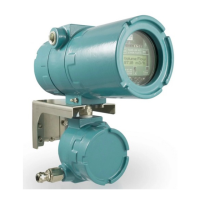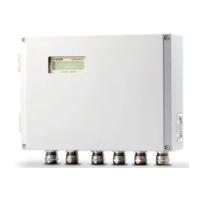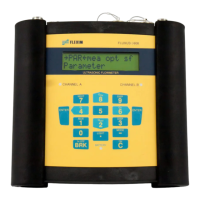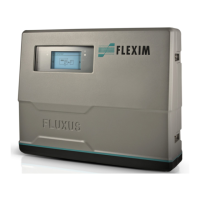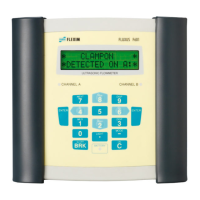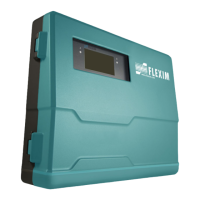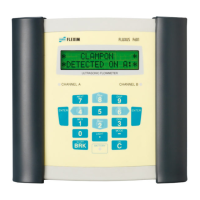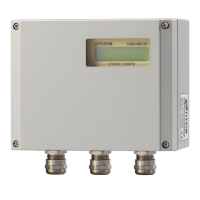Do you have a question about the Flexim FLUXUS G809 and is the answer not in the manual?
Explains various warning symbols used in the document for safety information.
Specifies that the operating instruction must be readily available where the equipment is used.
Provides general guidelines and emphasizes reading the entire instruction before work.
Defines the purpose of the measuring equipment and its limitations.
Covers essential safety measures for electrical connections, disconnections, and installations.
Explains the transit time difference correlation principle used for ultrasonic flow measurement.
Describes different ways transducers are mounted on the pipe for measurement.
Discusses the importance of flow profile development and selection of measurement points away from disturbances.
Guides on selecting optimal measuring points considering both flow profile and noise levels.
Describes the components of the measurement system: transmitter, transducers, and pipe.
Details how to navigate menus, scroll lists, and input data using the transmitter's interface.
Covers opening and closing the transmitter housing, and installation steps.
Covers preparation, selection of measuring points, and pipe preparation for transducer installation.
Guides on choosing an appropriate location for accurate measurement based on signal amplitude and flow profile.
Explains how to connect transducer cables to the transmitter's housings and terminals.
Details the installation and connection of the power supply, including safety requirements.
Describes how to connect output cables for transmitting measured values.
Explains how to connect to the transmitter via RS232 or RS485 interfaces.
Guides through initial configuration steps like language, units, and date/time settings.
Explains the process of resetting transmitter settings to factory defaults.
Describes how to view instrument details like serial number and firmware version.
Guides on entering essential pipe and fluid parameters for accurate measurement.
Covers configuration of measurement settings like physical quantity and units.
Guides on initiating the measurement process and activating measuring channels.
Explains how measured values are displayed and how to toggle between different quantities.
Addresses issues like no signal, no measured values, signal loss, and deviation from expected values.
Lists criteria for selecting an appropriate measuring point to avoid errors.
Explains causes for deviations like wrong sound speed, incorrect velocity limits, cut-off flow, and pipe roughness.
Outlines recommended maintenance intervals for different components like housing, transducers, and O-rings.
Details the importance of checking O-rings for integrity and proper sealing for explosion protection.
Guides on installing and activating binary outputs for signaling events or states.
Details how to configure frequency outputs to act as pulse outputs for totalizing quantities.
Describes how to enable or disable the data logger for storing measurement data.
Covers setting the start time, ringbuffer behavior, and storage mode for the data logger.
Details the process for deleting stored measurement data from the data logger.
Explains how to use terminal programs for transmitting data via ASCII format.
Details the configuration of serial transmission parameters for RS232 and RS485 interfaces.
Explains how totalizers work, display, storing, and behavior after measurement stops.
Details setting a lower limit for flow velocity, where values below are set to zero.
Explains settings for profile correction to improve accuracy, especially with non-ideal inflow conditions.
Introduces virtual calculation channels for processing data from measuring channels.
Explains how to enter and exit the SuperUser mode for advanced configuration.
Allows manual entry of transducer parameters in SuperUser mode.
Enables definition of flow parameters like profile bounds and velocity correction.
Enables setting a maximum signal amplification limit to prevent misinterpretation of noise or pipe signals.
Covers general dialog and menu settings, including pipe circumference configuration.
Covers configuration of gas measurement, sound speed comparison, and profile correction.
Allows setting standard pressure and temperature for gas measurements.
Explains how to set and use a program code to protect measurements from inadvertent intervention.
Provides a visual overview of the transmitter's menu structure and program branches.
Detailed diagram of the parameter input menu flow.
Diagram of the measurement settings menu flow.
Diagram illustrating the Data logger configuration options.
Table listing units for standard and operating volumetric flow rates, including totalized values.
Table listing units for mass flow rate and its totalized values.
Table providing sound speeds for various pipe and lining materials used in measurement.
Table showing properties of fluids like sound speed, viscosity, and density.
Explains various warning symbols used in the document for safety information.
Specifies that the operating instruction must be readily available where the equipment is used.
Provides general guidelines and emphasizes reading the entire instruction before work.
Defines the purpose of the measuring equipment and its limitations.
Covers essential safety measures for electrical connections, disconnections, and installations.
Explains the transit time difference correlation principle used for ultrasonic flow measurement.
Describes different ways transducers are mounted on the pipe for measurement.
Discusses the importance of flow profile development and selection of measurement points away from disturbances.
Guides on selecting optimal measuring points considering both flow profile and noise levels.
Describes the components of the measurement system: transmitter, transducers, and pipe.
Details how to navigate menus, scroll lists, and input data using the transmitter's interface.
Covers opening and closing the transmitter housing, and installation steps.
Covers preparation, selection of measuring points, and pipe preparation for transducer installation.
Guides on choosing an appropriate location for accurate measurement based on signal amplitude and flow profile.
Explains how to connect transducer cables to the transmitter's housings and terminals.
Details the installation and connection of the power supply, including safety requirements.
Describes how to connect output cables for transmitting measured values.
Explains how to connect to the transmitter via RS232 or RS485 interfaces.
Guides through initial configuration steps like language, units, and date/time settings.
Explains the process of resetting transmitter settings to factory defaults.
Describes how to view instrument details like serial number and firmware version.
Guides on entering essential pipe and fluid parameters for accurate measurement.
Covers configuration of measurement settings like physical quantity and units.
Guides on initiating the measurement process and activating measuring channels.
Explains how measured values are displayed and how to toggle between different quantities.
Addresses issues like no signal, no measured values, signal loss, and deviation from expected values.
Lists criteria for selecting an appropriate measuring point to avoid errors.
Explains causes for deviations like wrong sound speed, incorrect velocity limits, cut-off flow, and pipe roughness.
Outlines recommended maintenance intervals for different components like housing, transducers, and O-rings.
Details the importance of checking O-rings for integrity and proper sealing for explosion protection.
Guides on installing and activating binary outputs for signaling events or states.
Details how to configure frequency outputs to act as pulse outputs for totalizing quantities.
Describes how to enable or disable the data logger for storing measurement data.
Covers setting the start time, ringbuffer behavior, and storage mode for the data logger.
Details the process for deleting stored measurement data from the data logger.
Explains how to use terminal programs for transmitting data via ASCII format.
Details the configuration of serial transmission parameters for RS232 and RS485 interfaces.
Explains how totalizers work, display, storing, and behavior after measurement stops.
Details setting a lower limit for flow velocity, where values below are set to zero.
Explains settings for profile correction to improve accuracy, especially with non-ideal inflow conditions.
Introduces virtual calculation channels for processing data from measuring channels.
Explains how to enter and exit the SuperUser mode for advanced configuration.
Allows manual entry of transducer parameters in SuperUser mode.
Enables definition of flow parameters like profile bounds and velocity correction.
Enables setting a maximum signal amplification limit to prevent misinterpretation of noise or pipe signals.
Covers general dialog and menu settings, including pipe circumference configuration.
Covers configuration of gas measurement, sound speed comparison, and profile correction.
Allows setting standard pressure and temperature for gas measurements.
Explains how to set and use a program code to protect measurements from inadvertent intervention.
Provides a visual overview of the transmitter's menu structure and program branches.
Detailed diagram of the parameter input menu flow.
Diagram of the measurement settings menu flow.
Diagram illustrating the Data logger configuration options.
Table listing units for standard and operating volumetric flow rates, including totalized values.
Table listing units for mass flow rate and its totalized values.
Table providing sound speeds for various pipe and lining materials used in measurement.
Table showing properties of fluids like sound speed, viscosity, and density.
| Brand | Flexim |
|---|---|
| Model | FLUXUS G809 |
| Category | Measuring Instruments |
| Language | English |
